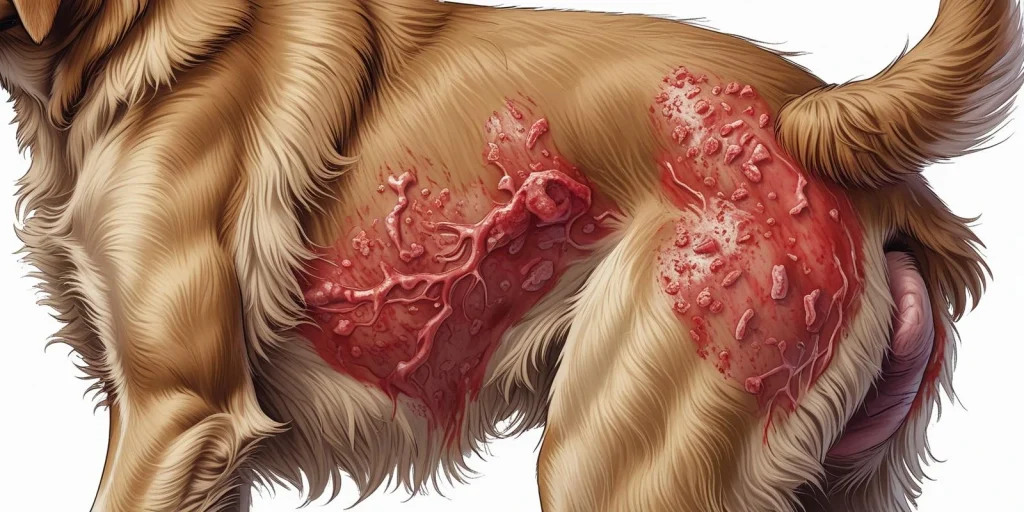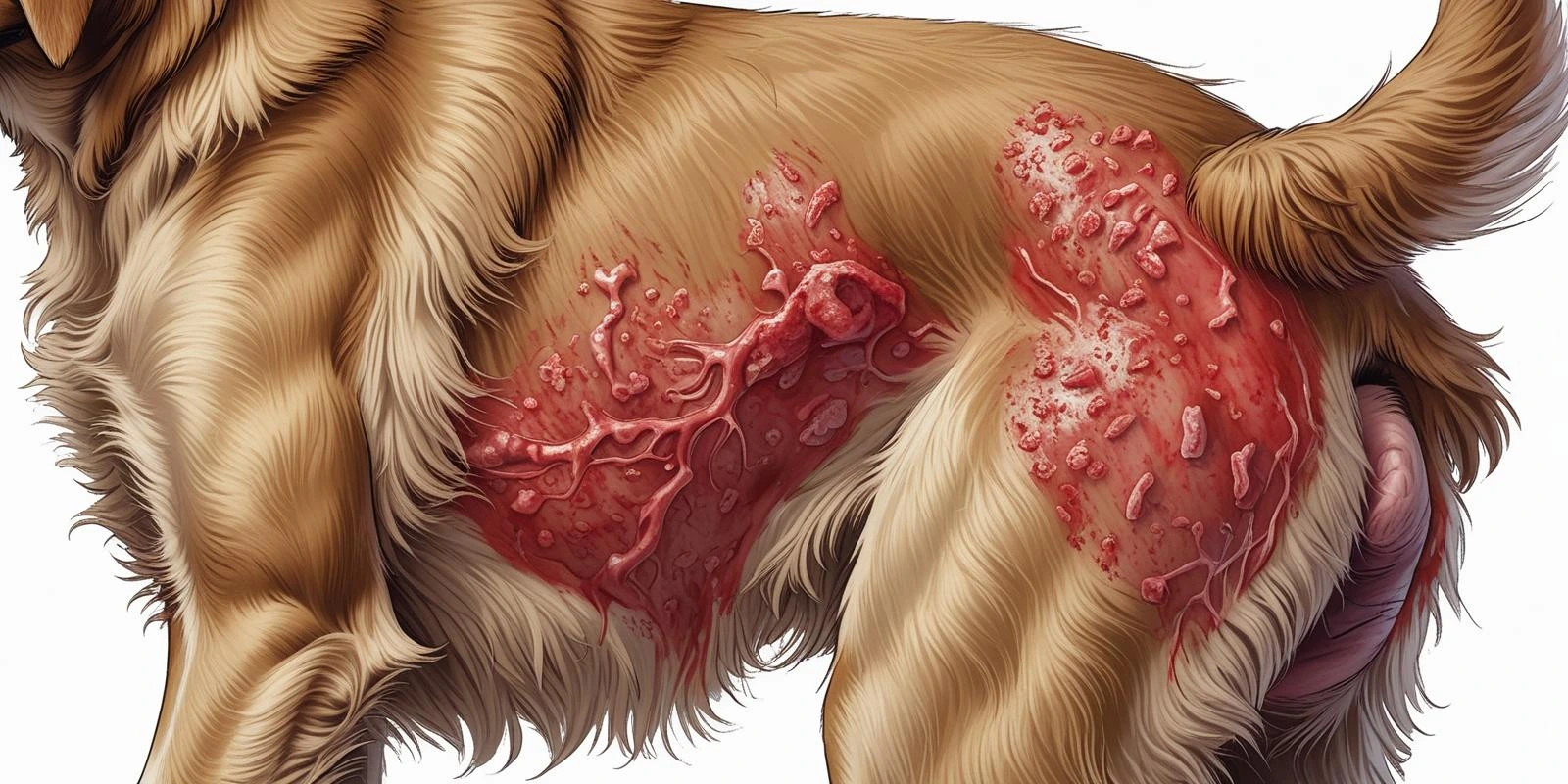Skin Allergies in Dogs: Unraveling and Managing Atopic Dermatitis
Skin Allergies in Dogs: Unraveling and Managing Atopic Dermatitis
Skin allergies, particularly atopic dermatitis, are one of the most common and frustrating conditions for dog owners and veterinarians alike. Characterized by intense itching and inflammation, these allergies can significantly impact a dog’s quality of life, leading to chronic discomfort, secondary infections, and a cycle of skin irritation. Understanding the multifaceted causes, diverse symptoms, comprehensive treatment options, and proactive prevention strategies for canine skin allergies (atopic dermatitis) is essential for providing long-term relief and improving the well-being of affected dogs. This in-depth article will explore every facet of skin allergies (atopic dermatitis), offering insights and practical advice to help manage this pervasive canine health issue.

The Root Causes: What Triggers Canine Skin Allergies (Atopic Dermatitis)?
Skin allergies (atopic dermatitis) in dogs are primarily immune-mediated, meaning they stem from an overreactive immune system that mistakenly identifies harmless substances as threats. These triggers, known as allergens, can be broadly categorized into three main groups:
- Environmental Allergens: These are by far the most common cause of skin allergies (atopic dermatitis) in dogs. Just like people, dogs can be allergic to airborne particles. Common environmental allergens include:
- Pollen: From trees, grasses, and weeds, often seasonal.
- Dust Mites: Microscopic creatures that live in household dust, bedding, and carpets, present year-round.
- Mold Spores: Found in damp environments, indoor and outdoor.
- Dander: From other animals (e.g., cats, horses).
- Food Allergens: While less common than environmental allergies, food allergies can cause very similar symptoms to skin allergies (atopic dermatitis). In food allergies, the dog’s immune system reacts adversely to specific proteins in their diet.
- Common culprits: Beef, chicken, dairy, wheat, soy, and sometimes fish or eggs.
- Important distinction: Food allergy is a true immune response, whereas food intolerance is a digestive issue without immune involvement. Both can cause gastrointestinal upset, but only food allergy causes dermatological signs.
- Flea Allergy Dermatitis (FAD): This is the most common allergic skin disease in dogs. It’s not the flea bite itself, but rather an allergic reaction to the proteins in the flea’s saliva that triggers intense itching and inflammation.
- Severe reaction: Even a single flea bite can cause a disproportionately severe allergic reaction in highly sensitive dogs, leading to widespread itching and irritation.
- Year-round concern: Fleas are not just a summer problem; they can infest homes year-round, making consistent flea control vital for preventing skin allergies (atopic dermatitis) caused by FAD.
A dog can be allergic to one or a combination of these allergens, making diagnosis and management of skin allergies (atopic dermatitis) a complex but rewarding endeavor. Genetic predisposition plays a significant role in atopic dermatitis, with certain breeds like French Bulldogs, Golden Retrievers, Labrador Retrievers, Boxers, and West Highland White Terriers being particularly susceptible.
The Itch Cycle: Recognizing Symptoms of Canine Skin Allergies (Atopic Dermatitis)
The hallmark symptom of skin allergies (atopic dermatitis) is intense itching (pruritus), which can manifest in various ways and often leads to a cascade of secondary issues.
- Intense Itching (Pruritus): The primary and most distressing symptom. Dogs will excessively scratch, lick, chew, and rub themselves on furniture or carpets. Common areas include the face (around the eyes and muzzle), ears, paws, armpits (axillae), and groin.
- Redness and Inflammation (Erythema): Affected skin areas will appear red and inflamed due to constant irritation.
- Hair Loss (Alopecia): Resulting from chronic scratching, licking, and chewing, leading to patchy or widespread hair loss.
- Skin Thickening (Lichenification): Over time, chronic inflammation and friction can cause the skin to become thickened, leathery, and hyperpigmented (darkened).
- Recurrent Ear Infections (Otitis Externa): The ears are often a target for skin allergies (atopic dermatitis). Dogs may experience chronic ear inflammation, redness, discharge, and odor, sometimes leading to head shaking and pain.
- Paw Licking/Chewing: Dogs with environmental allergies often lick and chew their paws incessantly, leading to red, inflamed, sometimes swollen paws.
- “Hot Spots” (Acute Moist Dermatitis): Rapidly appearing, moist, red, painful skin lesions that result from self-trauma (intense licking/chewing). These are often bacterial secondary infections.
- Secondary Bacterial or Yeast Infections: The damaged skin barrier and constant moisture from licking create a perfect environment for opportunistic bacteria (e.g., Staphylococcus) and yeast (Malassezia) to proliferate, leading to further itching, odor, and skin changes. These infections often require specific treatment beyond allergy management.
The constant discomfort from skin allergies (atopic dermatitis) can also lead to behavioral changes, including irritability, anxiety, restlessness, and a decreased interest in play or daily activities.
Comprehensive Management: Treatment for Canine Skin Allergies (Atopic Dermatitis)
Treating skin allergies (atopic dermatitis) is rarely a one-time fix but rather an ongoing management strategy that often involves a multimodal approach tailored to the individual dog. The goals are to control the itching, treat secondary infections, and identify/avoid triggers where possible.
- Controlling Itching and Inflammation:
- Antihistamines: Can be effective for some dogs with mild allergies, but often provide limited relief for moderate to severe skin allergies (atopic dermatitis). Common examples include diphenhydramine (Benadryl) or cetirizine (Zyrtec).
- Corticosteroids: Highly effective at reducing inflammation and itching, but long-term use can lead to significant side effects (increased thirst/urination, weight gain, panting, increased risk of infections, muscle weakness). Used cautiously, often for acute flare-ups.
- Cyclosporine (Atopica): An immunomodulator that helps regulate the immune response. It is highly effective for chronic skin allergies (atopic dermatitis) but takes several weeks to show full effect and can have gastrointestinal side effects initially.
- Oclacitinib (Apoquel): A Janus kinase (JAK) inhibitor that specifically targets pathways involved in itching and inflammation. It works quickly and effectively with fewer side effects than corticosteroids.
- Lokivetmab (Cytopoint): A monoclonal antibody injection that targets and neutralizes interleukin-31 (IL-31), a key cytokine responsible for sending the “itch” signal to the brain. It provides 4-8 weeks of itch relief, works quickly, and has minimal side effects as it is not metabolized through the liver or kidneys. This is a very targeted approach for skin allergies (atopic dermatitis).
- Medicated Shampoos and Topical Therapies:
- Antiseptic Shampoos: Containing ingredients like chlorhexidine or miconazole, these are crucial for treating secondary bacterial and yeast infections.
- Anti-itch Shampoos/Conditioners: Containing ingredients like colloidal oatmeal or pramoxine to provide temporary relief from itching.
- Topical Steroids/Immunomodulators: Creams, ointments, or sprays (e.g., hydrocortisone, tacrolimus) can be applied directly to localized itchy spots to reduce inflammation.
- Dietary Changes for Food Allergies:
- Novel Protein Diets: These diets contain protein sources the dog has never eaten before (e.g., duck, venison, rabbit, kangaroo) to avoid common allergens.
- Hydrolyzed Protein Diets: The proteins in these diets are broken down into very small pieces that the immune system is less likely to recognize as allergens.
- Strict Food Elimination Trial: This is the gold standard for diagnosing food allergies. The dog is fed only the novel or hydrolyzed diet for 8-12 weeks, with no other treats, chews, or flavored medications. If symptoms resolve, food challenges are then performed to identify the specific allergen. This is a critical step in managing food-induced skin allergies (atopic dermatitis).
- Addressing Secondary Infections:
- Antibiotics: Oral or topical antibiotics are prescribed to treat bacterial skin infections (pyoderma).
- Antifungals: Oral or topical antifungals are used for yeast infections (Malassezia dermatitis).
- Ear Cleaners and Medications: For otitis externa, specific ear cleaners and medicated drops are used to resolve infection and inflammation.
Proactive Prevention: Minimizing Exposure and Managing Fleas
Prevention is a cornerstone of managing skin allergies (atopic dermatitis), especially when environmental or flea allergens are involved.
- Allergen Control (Environmental):
- Dust Mites: Frequent washing of bedding in hot water, using allergen-proof covers, regular vacuuming (with HEPA filter), and keeping humidity low can help.
- Pollen: Wiping paws and coat after outdoor excursions, using air purifiers with HEPA filters, keeping windows closed during high pollen counts, and regular bathing can reduce exposure.
- Regular Bathing: Even for environmental allergies, regular bathing (1-2 times per week) with a gentle, hypoallergenic shampoo can wash away allergens from the coat and skin.
- Flea Treatment (Year-Round):
- Consistent Flea Prevention: This is paramount for flea allergy dermatitis. Use veterinary-recommended topical or oral flea preventatives year-round, even in winter months.
- Environmental Control: If a flea infestation is present, treating the home environment (vacuuming, washing bedding, possibly professional pest control) is also necessary.
- Supportive Supplements:
- Omega-3 Fatty Acids: Supplements containing EPA and DHA can help reduce inflammation and improve skin barrier health, working synergistically with other treatments for skin allergies (atopic dermatitis).
- Probiotics: Some research suggests that a healthy gut microbiome can influence immune function and potentially benefit skin health.
- Allergen-Specific Immunotherapy (ASIT) / Allergy Shots:
- Long-term solution: For environmental allergies, ASIT (also known as allergy shots or sublingual drops) is the only treatment that can actually modify the immune response and potentially “cure” the allergy.
- Process: After allergy testing (blood test or intradermal skin test) identifies the specific environmental allergens, a custom vaccine is formulated. The dog receives gradually increasing doses of the allergens over time, helping the immune system become desensitized.
- Patience required: ASIT takes 6-12 months to show noticeable improvement and requires a long-term commitment, but it can significantly reduce reliance on other medications and improve the dog’s quality of life. This is a highly effective, long-term approach to skin allergies (atopic dermatitis).
Reliable Product Links and Resources for Skin Allergy Management
As skin allergies (atopic dermatitis) require veterinary diagnosis and prescription medications, direct product purchase links for treatments are typically unavailable to consumers. However, I can provide examples of common product categories and reliable information resources.
Common Medications & Treatments (Prescription-only):
- Apoquel (oclacitinib): For targeted itch relief.
- Cytopoint (lokivetmab): An injectable monoclonal antibody for long-lasting itch relief.
- Atopica (cyclosporine): An oral immunomodulator for chronic cases.
- Steroids: Various forms (e.g., prednisone, prednisolone, topical hydrocortisone) for inflammation.
- Medicated Shampoos/Topicals: Brands like Douxo S3, Malaseb, or ResiCORT.
General Information and Trusted Resources (Consult your vet for product specifics):
- American Academy of Veterinary Dermatology (AAVD): https://www.aavd.org/ (Excellent resource for current information on dermatology conditions and finding board-certified dermatologists).
- Veterinary Partner (VIN): https://veterinarypartner.vin.com/default.aspx?pid=19239&id=4952093 (Search for “Atopic Dermatitis” or “Allergies” for detailed, vet-reviewed articles).
- Flea & Tick Preventatives: Reputable brands like Bravecto, NexGard, Simparica Trio, Credelio, Frontline, Advantage, or Revolution. Your vet can recommend the best option for your dog.
- Dermatology-focused diets: Brands like Royal Canin Hydrolyzed Protein, Purina Pro Plan Veterinary Diets HA Hydrolyzed, or Hill’s Prescription Diet z/d. These are only available through veterinarians.
- Omega-3 Fatty Acid Supplements: Many reputable brands available, look for those specifically for pets with high EPA/DHA concentrations, often sold through vet clinics or well-regarded pet supply stores.
Conclusion: A Partnership for Healthy Skin
Managing skin allergies (atopic dermatitis) in dogs is a journey that requires patience, persistence, and a strong partnership between pet owners and their veterinarians. It’s often a process of trial and error to identify triggers and find the most effective combination of treatments. While a complete “cure” for environmental skin allergies (atopic dermatitis) is rare, diligent management can significantly alleviate symptoms, prevent secondary infections, and dramatically improve a dog’s comfort and overall quality of life. By understanding the causes, recognizing the varied symptoms, exploring the range of treatment options, and committing to proactive prevention, dog owners can help their beloved companions live a happier, itch-free life, even with the challenges of skin allergies (atopic dermatitis).

